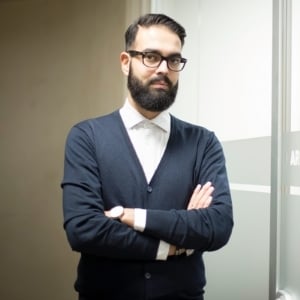Architectural Talks, the series of interviews by Manni Group in collaboration with YACademy, meets Federico Pompignoli of Studio 7478.
Ecco che cosa troverai in questo contenuto:
Federico Pompignoli and Studio 7478
From 2010 to 2019, Pompignoli worked at OMA where he led the project until the completion of the Fondazione Prada in Milan.
In 2019, he and the architect Alessandro De Santis founded Studio 7478, active to date on projects in Italy, the Middle East and Malta.
The firm is known for its attention to detail and environmental sustainability. It takes on architectural, urban planning, interior design and product design jobs, working internationally on projects of various sizes.
Manni Group interview with Federico Pompignoli of Studio 7478
MG: We are at Tower Prada. Regarding the rehabilitation of existing buildings, what role can dry construction and related technologies play?
Federico Pompignoli: I believe that dry technology is certainly fundamental, especially in redevelopment projects, as it can guarantee a certain speed of installation, keep costs under control, and from my point of view, it is a technology that can also guarantee a certain reversibility.
In the sense that, as far as redevelopment projects are concerned, I believe that the opportunity one has in converting a building and thus taking advantage of the possibilities that existing buildings still offer, is just as important if one considers the possibility of being able to go back and thus be able, at some point in the future, to remodel the project that has been done.
Therefore, from my point of view, the characterising element of dry solutions, i.e. elements ready to be installed easily, quickly and without too many interventions impacting the existing structure, also guarantees the possibility of converting these buildings in the future and thus remodelling our own projects.
MG: What do you think of the modularity that dry construction offers? Is this an obstacle or an opportunity in terms of respecting the creative ideas behind the project, the style and concept that the firm wants to convey through the project itself?
P: I believe that contemporary architecture has now reached a stage where modularity and the use of industrially derived products and solutions can no longer be ignored.
I think the trick is to be able to take advantage of these modular technologies that guarantee intrinsic quality, while retaining a margin of freedom for the architect in terms of finishes or the possibility of being adapted to contingent situations.
So modularity, in my opinion, is an advantage if it grants the architect some freedom.
MG: I think that the offsite industry, in the everyday on site experience, can probably really help you achieve those characteristics you wanted to obtain without having to depend on any randomness.
P: Exactly, I increasingly believe that architecture, in order to guarantee a good quality of execution that also reflects a certain coherence with the architectural concept, can no longer disregard the precision and quality that only industrial applications can guarantee.
So I am definitely in favour of these technologies, of these applications, and I believe that as a result the construction site increasingly becomes or should become the place where these technologies are assembled.
Preliminarily designed, defined, realised and certified in such a way as to limit more and more the on site-related part of exception or improvisation or correction of errors that risk undermining the final quality. What I aspire to as an architect, especially in the construction phase, is to be able to truly provide an industrial-type quality and precision of execution that only these technologies can guarantee.
MG: Offsite also means an impact on the concrete aspect of sustainability. Would you like to offer some comments, some examples, maybe past projects on this aspect?
P: From the point of view of so-called sustainability, rather than saying direct advantages in the use of sustainable materials per se, the real advantage lies in the management of the construction site and the exact timing of the entire cycle: fewer resources are consumed, timeframes are shortened with less energy-intensive systems and with a quality of materials that, as mentioned before, only an industrial solution can guarantee.
For example, limiting thermal bridges or the use of improvised solutions on the construction site, and certainly the possibility of reusing the same elements once they are disassembled, in a way that was foreseen from the start.
So there is no longer demolition and consequently the generation of waste, but simply reuse. From this point of view, therefore, I find these solutions interesting as they run parallel to a trend of reusing existing architectures. Therefore, instead of a mono-functional, disposable type of use, there is an increasing need to move towards the possibility of reusing elements, as well as reusing existing buildings.
MG: Since we are here at Tower Prada, what was the most difficult challenge you faced? Which perhaps gave you even more satisfaction once it was solved?
P: I have to say that although once the project was finished, and it was quite a long project and very demanding in many respects, you tend to only notice the flaws. What I think was actually a good result was the control of a certain level of quality, ubiquitously throughout the various stages of the project, with different materials and different technologies involved, thus being able to manage the project and ensure a good standard of quality and attention to detail.
And this involves existing buildings, but also new buildings, kinetic technologies and more traditional technologies, more classical materials and more innovative materials. This is what we were talking about earlier: I believe that the goal must increasingly be to be able to govern and guarantee a quality of detail, precision of execution, and control of resources that only the industrial world will be able to guarantee in the future.
MG: Thank you
P: Thank you to everyone


